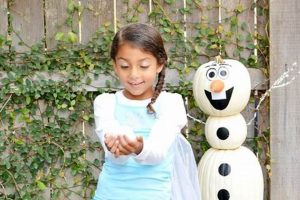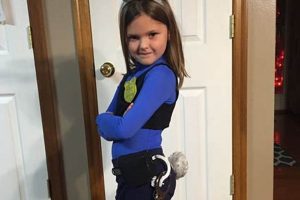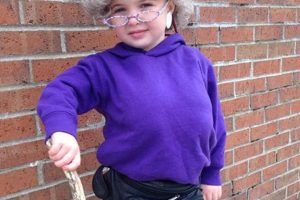Creating a garment replicating Belle’s attire from the animated film Beauty and the Beast through do-it-yourself methods is a popular undertaking. This commonly involves sourcing fabrics, adapting existing clothing, or constructing a new outfit from a pattern to resemble the iconic yellow ballgown or the simpler blue village dress worn by the character. For example, an individual might purchase yellow satin and tulle to construct a skirt and bodice, adding embellishments like rosettes or glitter to mimic the details of the formal gown.
The appeal of this crafting activity stems from several factors. It offers a cost-effective alternative to purchasing pre-made costumes, allows for personalization and unique expression, and provides a creative outlet for individuals with sewing or crafting skills. Historically, homemade clothing and costumes were commonplace, reflecting both economic constraints and a desire for individuality. This practice continues in the context of fandom and creative expression, enabling individuals to engage more deeply with beloved characters and stories.
Subsequent sections will explore specific design choices for recreating various iterations of the character’s outfits, detail material options and sourcing strategies, provide step-by-step construction guidance for essential elements, and offer tips for achieving a professional-looking finished product.
Crafting Belle’s Attire
Achieving a convincing and durable representation of Belle’s costumes requires careful planning and execution. The following guidelines offer insights into creating a high-quality, self-made version of her iconic outfits.
Tip 1: Fabric Selection is Paramount: Opt for materials that closely resemble the texture and drape of the fabrics used in the original designs. For the yellow ballgown, satin or crepe-back satin provides a suitable sheen and flow. Muslin or broadcloth are appropriate choices for the blue village dress.
Tip 2: Prioritize Accurate Pattern Drafting or Adaptation: Utilize existing patterns as a base, modifying them to match the specific design elements of the chosen costume version. Pay close attention to the silhouette and proportions to ensure an authentic look. A well-fitting bodice is especially crucial for the ballgown.
Tip 3: Embellishments Enhance Visual Appeal: Incorporate details such as rosettes, ruffles, or subtle embroidery to elevate the costume’s realism. For the ballgown, consider adding layers of tulle or organza to create volume and dimension in the skirt.
Tip 4: Pay Attention to Seam Finishes: Raw edges detract from the overall quality of the garment. Employ techniques such as serging, zig-zag stitching, or bias tape to create clean and durable seams. This is particularly important for fabrics that fray easily.
Tip 5: Consider Understructure for the Ballgown: A hoop skirt or petticoat will provide the necessary support and shape to achieve the iconic bell-shaped silhouette. The understructure should be lightweight and comfortable to wear for extended periods.
Tip 6: Accurate Color Matching is Essential: Strive to match the colors of the fabrics and embellishments as closely as possible to the source material. Reference high-quality images of the character to ensure accuracy. Natural lighting is ideal for assessing color matches.
Tip 7: Test Garment Construction is Recommended: Create a muslin mock-up of the costume before cutting into the final fabrics. This allows for adjustments to the fit and design, minimizing costly mistakes and ensuring a satisfactory outcome.
Achieving a successful outcome depends on meticulous planning, attention to detail, and a commitment to quality craftsmanship. These tips, when applied diligently, contribute to a visually appealing and durable creation that accurately represents the character’s iconic style.
Subsequent sections will provide more specific guidance on adapting existing patterns, crafting embellishments, and achieving a professional finish.
1. Pattern Selection
Pattern selection forms a foundational element in the successful execution of a do-it-yourself Beauty and the Beast character-inspired attire project. The chosen pattern dictates the costume’s overall silhouette, fit, and complexity, profoundly influencing the final product’s visual accuracy and wearability. Proper pattern selection streamlines the construction process and contributes significantly to a polished, professional-looking outcome.
- Accuracy of Silhouette and Detailing
The pattern’s design directly impacts the resemblance to the source material. A pattern offering accurate interpretations of the character’s attires key elements, such as the shape of the bodice or the fullness of the skirt, is crucial. For example, a pattern for Belle’s ballgown must accurately capture the bell shape of the skirt and the off-the-shoulder neckline. Deviation from these key details diminishes the costume’s recognizability.
- Skill Level Compatibility
Patterns range in complexity, catering to various skill levels. Choosing a pattern exceeding the crafter’s abilities can lead to frustration, errors, and a compromised finished product. Conversely, an overly simplistic pattern may lack the necessary details or construction techniques to create a truly impressive costume. A novice might select a pattern for the village dress, which generally involves simpler construction techniques, while an experienced sewer might tackle the ballgown with its intricate details.
- Fit and Customization Options
A well-fitting costume enhances the wearer’s comfort and overall appearance. Selecting a pattern that provides a range of sizes and offers options for customization allows for adjustments to accommodate individual body shapes and preferences. Features like multiple dart placements or adjustable seam allowances facilitate a more tailored fit. Adaptations can also allow for personal design choices, such as different sleeve lengths or neckline styles.
- Availability of Instructions and Support
The clarity and completeness of the pattern instructions significantly impact the ease of construction. A pattern with well-written, illustrated instructions and readily available support resources, such as online tutorials or community forums, can prove invaluable, especially for complex designs. Clear instructions help avoid errors and ensure a smoother construction process, improving the final costume.
In conclusion, judicious pattern selection streamlines the construction process and elevates the final product. It balances considerations of desired accuracy, personal skill, and available support, ensuring the DIY attire project successfully reflects the character’s iconic style while remaining achievable within the creator’s capabilities and resources.
2. Fabric Acquisition
Fabric acquisition represents a critical phase in any do-it-yourself Belle costume project. The selection and sourcing of appropriate materials directly influence the visual authenticity, durability, and overall success of the finished garment. Careful consideration of fabric types, costs, and availability is paramount.
- Authenticity and Visual Representation
The chosen fabrics must accurately reflect the textures and drapes associated with the character’s iconic costumes. For Belle’s yellow ballgown, materials like satin, crepe, or duchess satin provide a lustrous sheen and graceful flow. In contrast, the village dress typically requires more practical materials such as cotton, linen blends, or chambray. Inaccurate fabric choices diminish the recognizability and overall aesthetic impact of the costume.
- Budgetary Constraints and Material Costs
The cost of fabrics can significantly impact the overall budget of a do-it-yourself costume project. High-quality satins or silks can be expensive, while more affordable alternatives like polyester satin or cotton blends offer cost-effective solutions. Balancing desired aesthetic with budgetary limitations requires careful consideration of fabric prices, sales, and the potential for using remnant pieces or upcycled materials. This often involves compromises between ideal materials and financial realities.
- Fabric Durability and Wearability
The chosen fabrics should be durable enough to withstand wear and tear, especially if the costume is intended for frequent use or outdoor events. Fabrics like silk charmeuse, while beautiful, can be delicate and require special care. More robust options, such as polyester or cotton blends, offer greater resilience and ease of maintenance. This consideration is especially important for costumes worn by children or in demanding environments.
- Source Availability and Acquisition Methods
The ability to access and acquire desired fabrics is crucial for project feasibility. Local fabric stores offer the advantage of tactile assessment and immediate purchase. Online retailers provide a wider selection, often at competitive prices, but require careful consideration of color accuracy and shipping costs. Sourcing vintage or upcycled fabrics offers unique opportunities for cost savings and sustainable practices, but may require more extensive searching and cleaning efforts.
In summary, fabric acquisition stands as a cornerstone in the construction of a do-it-yourself Beauty and the Beast character-inspired attire. Balancing authenticity, budgetary constraints, fabric durability, and source availability dictates the project’s scope and ultimate success. Thoughtful fabric selection greatly enhances the visual appeal and longevity of the finished product.
3. Embellishment Techniques
Embellishment techniques hold significant importance in creating a convincing do-it-yourself Belle costume. These techniques add visual interest, realism, and character-specific details, elevating a basic garment into a recognizable representation of the character’s iconic attire. The appropriate application of embellishments contributes significantly to the overall success of the project.
- Ruching and Drapery
Ruching, the gathering or pleating of fabric to create a textured and voluminous effect, and drapery, the artful arrangement of fabric folds, are crucial for replicating the opulent look of Belle’s ballgown. These techniques often involve manipulating fabric strips or panels to create visual depth and complexity. Examples include ruching along the bodice or draping fabric to create swags or cascades on the skirt. These elements are key to capturing the grandeur associated with the character’s formal attire.
- Appliqu and Embroidery
Appliqu, the process of attaching fabric shapes to a background fabric, and embroidery, the embellishment of fabric with needlework, provide opportunities to add delicate and intricate details. Small fabric roses, beaded accents, or embroidered floral motifs can be applied to the bodice or skirt of either costume version. These embellishments contribute to the authenticity and visual appeal of the garment, adding a handcrafted quality that enhances the overall impression.
- Beading and Sequins
The strategic application of beads and sequins introduces subtle shimmer and texture. Beads can be sewn onto fabric edges or scattered across surfaces to catch the light. Sequins, either individually applied or attached in strands, create a more pronounced sparkle. When used sparingly and appropriately, these embellishments can enhance the luxurious feel of Belles ballgown, adding a touch of magic and elegance.
- Fabric Painting and Dyeing
Fabric painting and dyeing techniques allow for the customization of fabric colors and patterns. Fabric paints can be used to create subtle shading, add details, or replicate patterns. Dyeing allows for the transformation of fabric colors to match specific costume requirements. These techniques offer flexibility in achieving the desired visual effect, especially when sourcing fabrics that are not readily available in the required colors or patterns.
Ultimately, the choice and application of embellishment techniques are instrumental in transforming a basic do-it-yourself project into a visually compelling and character-accurate Belle costume. These techniques not only enhance the aesthetic appeal but also reflect the dedication and craftsmanship invested in the creation, capturing the essence of the beloved character’s iconic style.
4. Construction Skill
Successful execution of a self-made Belle costume is directly contingent upon the constructor’s skill level. The complexity of the design, particularly the intricate details of the ballgown, necessitates a competent understanding of sewing techniques, pattern manipulation, and fabric handling. Insufficient skill invariably leads to a compromised final product, characterized by poor fit, visible construction flaws, and diminished visual accuracy. For instance, attempting to construct the ballgown’s draped skirt without proficiency in gathering, pleating, and securing multiple fabric layers will likely result in a misshapen and unappealing garment. Similarly, accurately fitting the bodice requires a thorough understanding of dart placement, seam allowances, and body measurements, skills that develop through experience and dedicated practice.
Individuals with limited sewing experience may benefit from initiating the project with Belle’s simpler village dress. This garment’s relatively straightforward construction allows for the development of foundational skills, such as basic seam construction, zipper insertion, and hem finishing. Mastering these fundamental techniques provides a solid base upon which to progressively tackle more complex designs. Alternatively, experienced seamstresses can leverage their expertise to adapt existing patterns, draft custom designs, and incorporate advanced techniques like couture sewing or intricate embroidery. The ability to interpret and modify patterns is invaluable for achieving a precise fit and incorporating personalized design elements, further enhancing th
e costume’s authenticity and uniqueness.
In conclusion, construction skill is not merely an ancillary factor but a determining element in the successful realization of a self-created Belle costume. The garment’s complexity demands proficiency in various sewing techniques, and the constructor’s skill level directly influences the quality and accuracy of the final product. Recognizing and addressing individual skill limitations allows for strategic planning, appropriate pattern selection, and the development of necessary expertise, thereby maximizing the likelihood of achieving a visually compelling and skillfully crafted representation of the iconic character’s attire.
5. Budget Management
Effective budget management is an indispensable component of any “diy belle costume” endeavor, dictating the scope, materials utilized, and ultimately, the overall quality of the finished product. Insufficient budgetary planning often results in compromises on fabric quality, detail omissions, or even project abandonment due to unforeseen expenses. Conversely, a well-defined budget enables the careful allocation of resources, allowing for the acquisition of appropriate materials, the purchase or rental of necessary tools, and the contingency planning for potential cost overruns. The failure to adequately manage finances can, therefore, directly impact the costume’s authenticity, durability, and visual appeal.
Consider the creation of Belle’s iconic ballgown. Fabric costs can vary widely, ranging from inexpensive polyester satins to more luxurious silks and velvets. A constrained budget might necessitate the selection of less costly materials, impacting the garment’s drape and sheen. Similarly, embellishments like lace, beads, and appliques contribute significantly to the costume’s visual accuracy but also add to the overall expense. Prioritizing specific details and allocating funds accordingly becomes crucial. For example, an individual might opt for less expensive fabric to allocate more funds toward higher-quality lace for the bodice, thus maintaining the costume’s overall aesthetic despite budgetary limitations. Furthermore, unexpected costs such as thread, zippers, or pattern adjustments must be anticipated and accounted for within the initial budget. Ignoring these potential expenses can lead to financial strain and necessitate alterations to the design or material choices.
In conclusion, prudent budget management stands as a cornerstone for realizing a successful self-made Belle costume. Its influence extends beyond mere financial considerations, impacting the costume’s authenticity, longevity, and visual impact. By establishing a comprehensive budget, anticipating potential expenses, and allocating resources strategically, individuals can effectively navigate the challenges associated with creating a visually stunning and durable garment that accurately reflects the character’s iconic style, all without exceeding their financial constraints.
Frequently Asked Questions
The following addresses common inquiries and concerns regarding the creation of a self-made Belle costume, providing clear and concise answers to facilitate a successful crafting experience.
Question 1: What fabric type is most suitable for Belle’s ballgown?
Satin, crepe-back satin, or duchess satin are viable options. These fabrics possess the requisite sheen and drape to emulate the opulent appearance of the iconic yellow gown. Muslin can be used as a lining.
Question 2: How can the ballgown’s skirt achieve its voluminous shape?
The skirt’s shape is typically achieved through the use of a hoop skirt or petticoat worn underneath. Multiple layers of tulle or organza can also be added to the skirt’s lining to increase volume.
Question 3: Is prior sewing experience necessary to create a convincing Belle costume?
The complexity of the project depends on the chosen design. The simpler village dress is suitable for novice sewers, while the intricate ballgown requires advanced skills in pattern manipulation and garment construction.
Question 4: How can the costume be made more durable for frequent wear?
Reinforcing seams, using durable fabrics, and properly finishing raw edges will enhance the costume’s longevity. Selecting machine-washable fabrics can also simplify maintenance.
Question 5: Are there cost-effective alternatives to purchasing expensive fabrics?
Polyester satin offers a less expensive alternative to silk or silk blends. Utilizing remnant fabrics, upcycling existing garments, or shopping during sales can further reduce material costs.
Question 6: Where can suitable patterns for Belle’s costumes be found?
Commercial pattern companies such as Simplicity, McCall’s, and Butterick offer patterns for various iterations of Belle’s attire. Online marketplaces and crafting websites also provide a range of downloadable patterns.
Successful creation necessitates meticulous planning, careful material selection, and skillful execution. Addressing these frequent questions provides a solid foundation for a satisfying and successful outcome.
The subsequent section will provide detailed instructions on adapting existing patterns to create specific elements of the Belle costume.
Conclusion
This article has explored the diverse facets of “diy belle costume” creation, encompassing pattern selection, fabric acquisition, embellishment techniques, necessary construction skills, and effective budget management. Successfully executing such a project requires careful consideration of each of these elements, balancing design accuracy with individual skill levels and available resources. Thorough planning and diligent execution are paramount to achieving a visually compelling and durable final product.
The creation of a self-made Belle costume represents more than mere replication; it embodies a convergence of artistic expression, technical skill, and dedication to detail. Continued exploration of these crafting techniques, alongside advancements in textile technology and pattern design, promises to further enhance the potential for achieving increasingly sophisticated and personalized results, allowing crafters to more fully express their fandom and creative vision.







